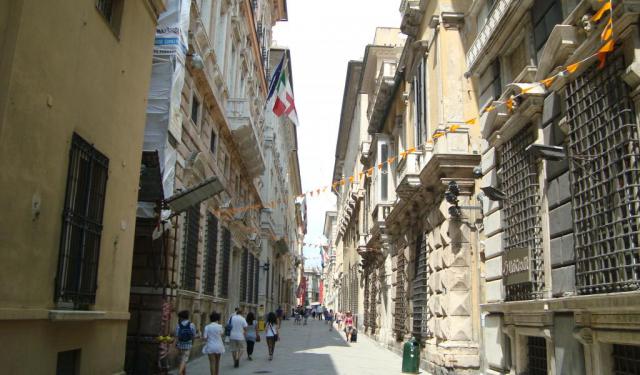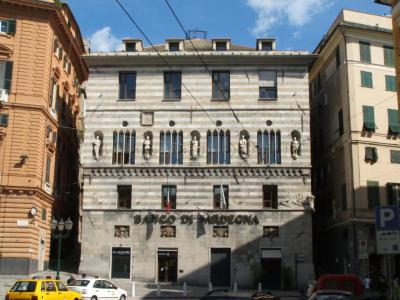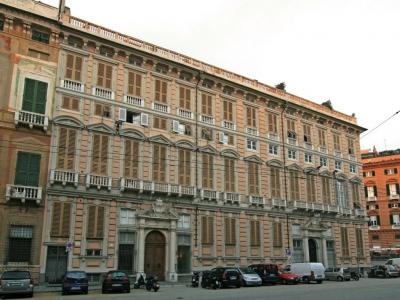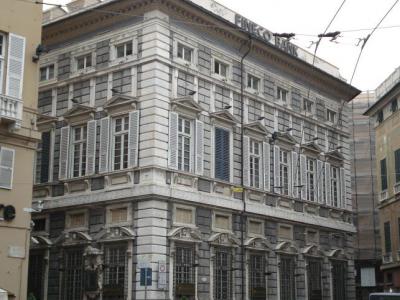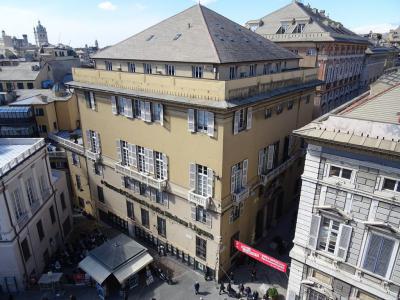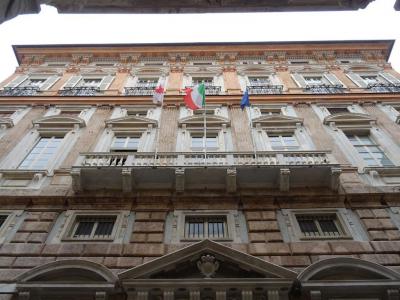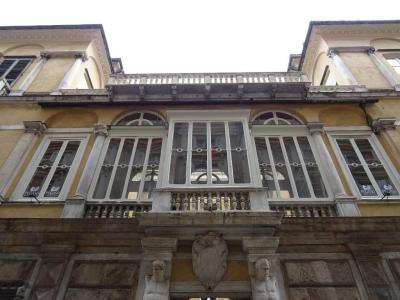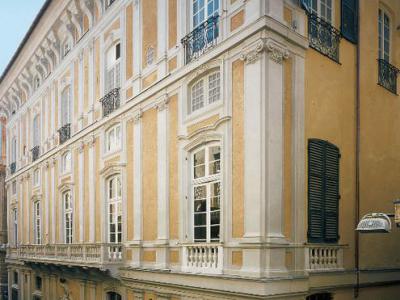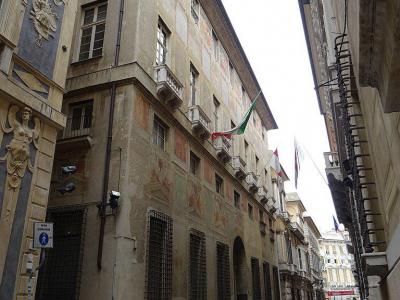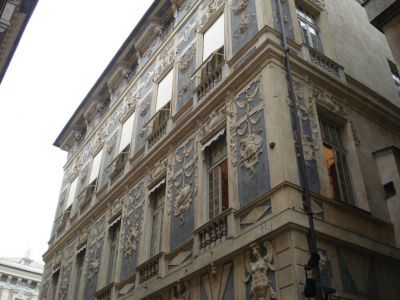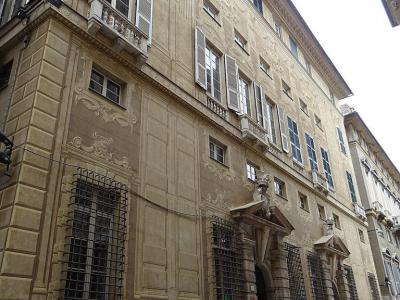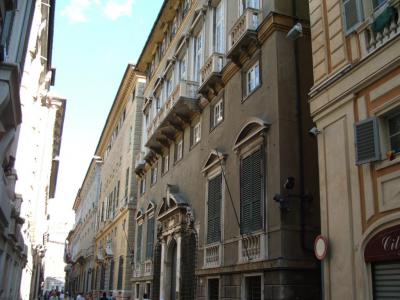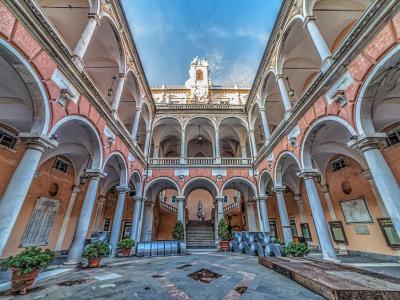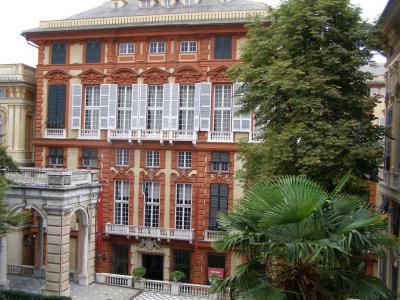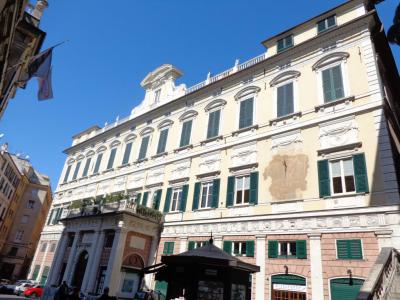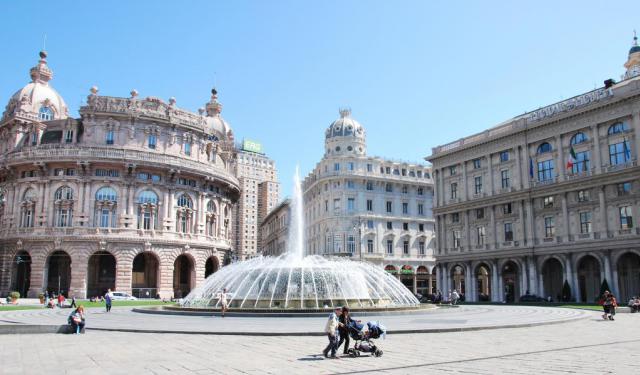Rolli Palaces Walking Tour (Self Guided), Genoa
The Rolli di Genova – or, more precisely, the Rolli degli alloggiamenti pubblici di Genova (Italian for "Lists of the public lodgings of Genoa") – were first established in the Republic of Genoa in 1576. Originally, these official lists included private palaces and mansions belonging to the most distinguished local families, which - if chosen through a public lottery - were obliged to host the most notable guests during their State visit to the Republic.
One such guest of honor, the Dutch painter Peter Paul Rubens, clearly impressed by the curious accommodation system and the architectural quality of Genoese palaces, published in 1622 a book accompanied by illustrations, called “Palazzi di Genova”, owing to which, in large part, these palaces were declared UNESCO World Heritage in 2006.
Today, the Rolli Palaces are a collective term referring to 42 of the most prominent palaces in the historic center of Genoa, situated predominantly along Via Garibaldi (formerly, Strada Nuova).
Some of these properties are used as public buildings or museums. Among those open to the public are Palazzo Rosso, Palazzo Bianco and Palazzo Doria Tursi, which jointly constitute the Strada Nuova Museums. In some cases, the palaces in question still belong to private owners, while others, like Palazzo Pallavicini Cambiaso, Palazzo Spinola Gambaro or Palazzo Carrega-Cataldi, are the headquarters of banks or offices.
The best way to explore the Rolli Palaces is a guided tour. Luckily, with the help of GPSmyCity mobile app, you can do it yourself, at your own pace and in your good time. Just embark on this self-guided walk and see for yourself!
One such guest of honor, the Dutch painter Peter Paul Rubens, clearly impressed by the curious accommodation system and the architectural quality of Genoese palaces, published in 1622 a book accompanied by illustrations, called “Palazzi di Genova”, owing to which, in large part, these palaces were declared UNESCO World Heritage in 2006.
Today, the Rolli Palaces are a collective term referring to 42 of the most prominent palaces in the historic center of Genoa, situated predominantly along Via Garibaldi (formerly, Strada Nuova).
Some of these properties are used as public buildings or museums. Among those open to the public are Palazzo Rosso, Palazzo Bianco and Palazzo Doria Tursi, which jointly constitute the Strada Nuova Museums. In some cases, the palaces in question still belong to private owners, while others, like Palazzo Pallavicini Cambiaso, Palazzo Spinola Gambaro or Palazzo Carrega-Cataldi, are the headquarters of banks or offices.
The best way to explore the Rolli Palaces is a guided tour. Luckily, with the help of GPSmyCity mobile app, you can do it yourself, at your own pace and in your good time. Just embark on this self-guided walk and see for yourself!
How it works: Download the app "GPSmyCity: Walks in 1K+ Cities" from Apple App Store or Google Play Store to your mobile phone or tablet. The app turns your mobile device into a personal tour guide and its built-in GPS navigation functions guide you from one tour stop to next. The app works offline, so no data plan is needed when traveling abroad.
Rolli Palaces Walking Tour Map
Guide Name: Rolli Palaces Walking Tour
Guide Location: Italy » Genoa (See other walking tours in Genoa)
Guide Type: Self-guided Walking Tour (Sightseeing)
# of Attractions: 15
Tour Duration: 1 Hour(s)
Travel Distance: 0.4 Km or 0.2 Miles
Author: ChristineCu
Sight(s) Featured in This Guide:
Guide Location: Italy » Genoa (See other walking tours in Genoa)
Guide Type: Self-guided Walking Tour (Sightseeing)
# of Attractions: 15
Tour Duration: 1 Hour(s)
Travel Distance: 0.4 Km or 0.2 Miles
Author: ChristineCu
Sight(s) Featured in This Guide:
- Palazzo Giacomo Spinola "dei Marmi" (Spinola Palace)
- Palazzo Ayrolo Negrone (Ayrolo Negrone Palace)
- Palazzo Pallavicini-Cambiaso (Pallavicini-Cambiaso Palace)
- Palazzo Spinola Gambaro (Spinola Gambaro Palace)
- Palazzo Carrega-Cataldi (Carrega-Cataldi Palace)
- Palazzo Lercari-Parodi (Lercari-Parodi Palace)
- Palazzo Doria (Doria Palace)
- Palazzo Angelo Giovanni Spinola (Angelo Giovanni Spinola Palace)
- Palazzo Lomellino (Lomellino Palace)
- Palazzo Cattaneo-Adorno (Cattaneo-Adorno Palace)
- Palazzo Campanella (Bell Palace)
- Palazzo Doria Tursi (Doria Tursi Palace)
- Palazzo Rosso (Red Palace)
- Palazzo Bianco (White Palace)
- Palazzo Gerolamo Grimaldi (Gerolamo Grimaldi Palace)
1) Palazzo Giacomo Spinola "dei Marmi" (Spinola Palace)
The Giacomo Spinola Palace is located in the Piazza della Fontane Marose number 6. It is listed in the Rolli of Genoa and is a UNESCO World Heritage site. Currently it is home to the Bank of Sardegna. It was built for Giacomo Spinola between 1445 and 1450.
It has a facade with niches holding statues of illustrious family members. The building is noted for its black and white facade. This was an honor that was given to only the four leading families of the city. They were Doria, Spinola, Fieschi, and Grimaldi.
The Palace was the first to manifest the Genoese penchant of building up onto a hill slope behind the building. This practice made possible surprising ponds, gardens and terraces.
In the 19th century the Via 25th April was opened and the level of the Piazza Fontane Marose was lowered. Together with 20th century restoration work, this had only a slight effect on the characteristics of the building.
The building is not open to the public as it is the home office of a bank.
It has a facade with niches holding statues of illustrious family members. The building is noted for its black and white facade. This was an honor that was given to only the four leading families of the city. They were Doria, Spinola, Fieschi, and Grimaldi.
The Palace was the first to manifest the Genoese penchant of building up onto a hill slope behind the building. This practice made possible surprising ponds, gardens and terraces.
In the 19th century the Via 25th April was opened and the level of the Piazza Fontane Marose was lowered. Together with 20th century restoration work, this had only a slight effect on the characteristics of the building.
The building is not open to the public as it is the home office of a bank.
2) Palazzo Ayrolo Negrone (Ayrolo Negrone Palace)
The Ayrolo Negrone Palace is a remarkable example of Renaissance-Baroque architecture. It belongs to the esteemed group of Rolli Palaces-historic residences that once accommodated visiting dignitaries during the Republic of Genoa and are now recognized as UNESCO World Heritage Sites.
The palace we see today is the result of centuries of architectural evolution. Its origins date back to around 1560–62, when it was created by combining two houses-one originally built for the Spanish ambassador Francesco De Ugarte. In the early 1600s, under Gio Tommaso Ayrolo, the two wings were reunited, and by 1657 it came under the care of the Negrone family.
While expansions continued-such as 18th-century façade renovation by Antonio Barabino and addition of dual marble portals in 1870-the interior's crowning glory remains the 17th-century gallery frescoed by Giovanni Battista Carlone. Illuminated by large windows, this hall depicts scenes from the Aeneid in vivid color and perspective-enhancing design.
Although still privately owned and not regularly open to the public, the Ayrolo Negrone Palace offers a fascinating glimpse into Genoa’s aristocratic grandeur. Visitors can admire its richly decorated façade, twin entrances, and ornate windows from the Fontane Marose Square-and occasionally gain insider access during special guided tours or cultural events that reveal the ornate frescoed gallery and splendid decorations inside.
The palace we see today is the result of centuries of architectural evolution. Its origins date back to around 1560–62, when it was created by combining two houses-one originally built for the Spanish ambassador Francesco De Ugarte. In the early 1600s, under Gio Tommaso Ayrolo, the two wings were reunited, and by 1657 it came under the care of the Negrone family.
While expansions continued-such as 18th-century façade renovation by Antonio Barabino and addition of dual marble portals in 1870-the interior's crowning glory remains the 17th-century gallery frescoed by Giovanni Battista Carlone. Illuminated by large windows, this hall depicts scenes from the Aeneid in vivid color and perspective-enhancing design.
Although still privately owned and not regularly open to the public, the Ayrolo Negrone Palace offers a fascinating glimpse into Genoa’s aristocratic grandeur. Visitors can admire its richly decorated façade, twin entrances, and ornate windows from the Fontane Marose Square-and occasionally gain insider access during special guided tours or cultural events that reveal the ornate frescoed gallery and splendid decorations inside.
3) Palazzo Pallavicini-Cambiaso (Pallavicini-Cambiaso Palace)
Pallavicini-Cambiaso Palace is a Renaissance palace, commissioned in 1558 by Agostino Pallavicini, who served as Genoa’s ambassador to the Spanish court. It was the very first grand palace to open onto the prestigious street, setting the tone for the majestic buildings to follow.
Designed by architect Bernardino Cantone, the palace features a refined ashlar façade of rusticated gray stone and white marble trim. Its Mannerist portal, decorated with carved ox skulls (bucrania), and an 18th-century devotional niche mark the entrance. In 1592, it hosted Duke Vincenzo I Gonzaga of Mantua, confirming its high status among Genoa’s ruling families.
Inside, the noble floor is adorned with frescoes that highlight Genoa’s artistic heritage. Visitors can admire The Rape of the Sabines in the reception room and the History of Cupid and Psyche in the grand hall-both masterful creations by Andrea and Ottavio Semino, evoking the humanistic and mythological tastes of the era. Moreover, in the early 1600s, Niccolò Pallavicini, Agostino’s son, hosted Peter Paul Rubens here and commissioned the painter’s portrait of himself and his wife-celebrating the palace’s link to artistic innovation.
Today, the Pallavicini-Cambiaso Palace remains under the ownership of a prominent financial institution, but it continues to shine as a defining feature of the Palaces of the Rolli and the UNESCO-listed New Streets complex. While not regularly open for walkthrough visits, its majestic façade can be admired from the street, and part of its legacy lives on in Rubens’s 1622 engravings.
Designed by architect Bernardino Cantone, the palace features a refined ashlar façade of rusticated gray stone and white marble trim. Its Mannerist portal, decorated with carved ox skulls (bucrania), and an 18th-century devotional niche mark the entrance. In 1592, it hosted Duke Vincenzo I Gonzaga of Mantua, confirming its high status among Genoa’s ruling families.
Inside, the noble floor is adorned with frescoes that highlight Genoa’s artistic heritage. Visitors can admire The Rape of the Sabines in the reception room and the History of Cupid and Psyche in the grand hall-both masterful creations by Andrea and Ottavio Semino, evoking the humanistic and mythological tastes of the era. Moreover, in the early 1600s, Niccolò Pallavicini, Agostino’s son, hosted Peter Paul Rubens here and commissioned the painter’s portrait of himself and his wife-celebrating the palace’s link to artistic innovation.
Today, the Pallavicini-Cambiaso Palace remains under the ownership of a prominent financial institution, but it continues to shine as a defining feature of the Palaces of the Rolli and the UNESCO-listed New Streets complex. While not regularly open for walkthrough visits, its majestic façade can be admired from the street, and part of its legacy lives on in Rubens’s 1622 engravings.
4) Palazzo Spinola Gambaro (Spinola Gambaro Palace)
Spinola Gambaro Palace is a sumptuous Renaissance masterpiece, commissioned in 1558 by Pantaleo Spinola and designed by Bernardo Spazio with completion by Pietro Orsolino, it stands as the first grand palace on the lower side of Strada Nuova and was listed among the prestigious Rolli palaces by 1576.
The palace’s exterior is elegantly understated, featuring a simple plastered façade enlivened only by the rhythmic windows, projecting balconies, and a grand marble portal guarded by statues representing Prudence and Vigilance. Inside, the ground floor is adorned with rich biblical frescoes by Giovanni Carlone-depicting scenes such as Susannah and the Elders, The Judgement of Solomon, and The Death of Absalom-marking his final contributions to Genoese Mannerism.
During the 17th century, the palace passed from the Spinolas to the Giustiniani and later the Gambaro family. In the 19th century, following its acquisition by the Bank of Chiavari and the Ligurian Riviera, the courtyard was covered, and the ground-floor hall was revamped with allegorical frescoes celebrating national progress and the Liberal Arts. Today, the bank’s public spaces occasionally host cultural events, offering visitors a rare chance to experience the palace’s gilt-edged grandeur.
As part of the UNESCO-listed Genoa: Le Strade Nuove and the system of the Palazzi dei Rolli, Spinola Gambaro Palace remains a living testament to the city’s architectural legacy.
The palace’s exterior is elegantly understated, featuring a simple plastered façade enlivened only by the rhythmic windows, projecting balconies, and a grand marble portal guarded by statues representing Prudence and Vigilance. Inside, the ground floor is adorned with rich biblical frescoes by Giovanni Carlone-depicting scenes such as Susannah and the Elders, The Judgement of Solomon, and The Death of Absalom-marking his final contributions to Genoese Mannerism.
During the 17th century, the palace passed from the Spinolas to the Giustiniani and later the Gambaro family. In the 19th century, following its acquisition by the Bank of Chiavari and the Ligurian Riviera, the courtyard was covered, and the ground-floor hall was revamped with allegorical frescoes celebrating national progress and the Liberal Arts. Today, the bank’s public spaces occasionally host cultural events, offering visitors a rare chance to experience the palace’s gilt-edged grandeur.
As part of the UNESCO-listed Genoa: Le Strade Nuove and the system of the Palazzi dei Rolli, Spinola Gambaro Palace remains a living testament to the city’s architectural legacy.
5) Palazzo Carrega-Cataldi (Carrega-Cataldi Palace)
The Carrega-Cataldi Palace, once known as the Tobia Pallavicino Palace, is a refined example of Mannerist architecture. Constructed between 1558 and 1561 for the affluent merchant Tobia Pallavicino, it was designed by Giovanni Battista Castello. The façade reflects Renaissance elegance, featuring rusticated stonework at street level, Ionic pilasters on the upper floor, and a balanced three-bay composition.
In the early 18th century, the palace passed into the Carrega family’s hands. They added a full extra story, two new wings, and internal courtyard expansions, transforming it into a Baroque masterpiece with elaborately frescoed interiors. Notably, the "Golden Gallery" was painted between 1740 and 1744 by Lorenzo De Ferrari in a lavish Rococo style.
Since 1922, the building has served as the headquarters of Genoa’s Chamber of Commerce. Though its function is primarily institutional, guided tours and open-house events during the Rolli Days occasionally allow visitors inside. These reveal grand reception rooms: marble staircases, frescoed halls, and the famed Golden Gallery-a vivid illustration of Genoese civic power and artistic flair.
A UNESCO World Heritage Site since 2006, the Carrega-Cataldi Palace stands as one of the 42 Rolli Palaces included under “Genoa: The Strade Nuove and the System of the Palazzi dei Rolli”.
In the early 18th century, the palace passed into the Carrega family’s hands. They added a full extra story, two new wings, and internal courtyard expansions, transforming it into a Baroque masterpiece with elaborately frescoed interiors. Notably, the "Golden Gallery" was painted between 1740 and 1744 by Lorenzo De Ferrari in a lavish Rococo style.
Since 1922, the building has served as the headquarters of Genoa’s Chamber of Commerce. Though its function is primarily institutional, guided tours and open-house events during the Rolli Days occasionally allow visitors inside. These reveal grand reception rooms: marble staircases, frescoed halls, and the famed Golden Gallery-a vivid illustration of Genoese civic power and artistic flair.
A UNESCO World Heritage Site since 2006, the Carrega-Cataldi Palace stands as one of the 42 Rolli Palaces included under “Genoa: The Strade Nuove and the System of the Palazzi dei Rolli”.
6) Palazzo Lercari-Parodi (Lercari-Parodi Palace)
Lercari-Parodi Palace, often referred to as the Franco Lercari Palace, is a Renaissance monument. Commissioned between 1571 and 1578 by Franco Lercari-a powerful banker and one-time governor of the Republic of Genoa-the palace was an expression of his immense wealth and status. Its inclusion in Genoa’s prestigious Rolli system from 1576 marks it as a first-class venue for hosting official guests.
What makes this palace unique is its architecture. The ground floor features diamond-point ashlar masonry, while the upper levels originally featured open loggias similarly depicted in Peter Paul Rubens’ 17th-century engravings of Genoese palaces. The richly ornamented portal is flanked by two male telamons carved by Taddeo Carlone, humorously depicted with broken noses-a nod to an ancestral legend involving Megollo Lercari’s vengeance.
The interior is just as captivating. The first “noble floor” is graced with frescoes by Lazzaro and Pantaleo Calvi-landscapes and biblical scenes-alongside a stunning Luca Cambiaso fresco depicting episodes from the myth of Niobe. Upstairs, a grand fresco of Megollo Lercari’s building of the Genoese trading post in Trebizond-a masterwork of Genoese Mannerism-still resonates with historic pride.
Though still privately owned by the Parodi family since 1845, Palazzo Lercari-Parodi opens to the public during Rolli Days and special events.
What makes this palace unique is its architecture. The ground floor features diamond-point ashlar masonry, while the upper levels originally featured open loggias similarly depicted in Peter Paul Rubens’ 17th-century engravings of Genoese palaces. The richly ornamented portal is flanked by two male telamons carved by Taddeo Carlone, humorously depicted with broken noses-a nod to an ancestral legend involving Megollo Lercari’s vengeance.
The interior is just as captivating. The first “noble floor” is graced with frescoes by Lazzaro and Pantaleo Calvi-landscapes and biblical scenes-alongside a stunning Luca Cambiaso fresco depicting episodes from the myth of Niobe. Upstairs, a grand fresco of Megollo Lercari’s building of the Genoese trading post in Trebizond-a masterwork of Genoese Mannerism-still resonates with historic pride.
Though still privately owned by the Parodi family since 1845, Palazzo Lercari-Parodi opens to the public during Rolli Days and special events.
7) Palazzo Doria (Doria Palace)
Doria Palace is a dazzling example of Genoese Renaissance architecture. Commissioned by the Spinola brothers around 1563 and nearing completion by 1567, its elegant Mannerist façade and richly detailed marble portal make it a highlight of this UNESCO-listed street that once hosted the Republic of Genoa’s most important diplomatic visitors.
In the late 1500s, the palace passed into the hands of the Doria family-cousins of the legendary Admiral Andrea Doria-and earned its current name. Opulent decorative additions continued under Carlo Doria, Duke of Tursi, in 1597, including grand loggias and an ornate clock tower by Carlo Randoni, blending pink Finale stone, grey slate, and Carrara marble into a façade statement.
While its sumptuous interior is no longer a public museum, parts of the building remain accessible behind its imposing portal. Carefully designed spatial flow-from atrium to grand staircase to a raised rectangular courtyard-demonstrates the height of aristocratic residential design. The richly frescoed reception halls, once adorned with masterpieces by Cambiaso and Ansaldo, speak to a bygone era of ceremonial grandeur.
In the late 1500s, the palace passed into the hands of the Doria family-cousins of the legendary Admiral Andrea Doria-and earned its current name. Opulent decorative additions continued under Carlo Doria, Duke of Tursi, in 1597, including grand loggias and an ornate clock tower by Carlo Randoni, blending pink Finale stone, grey slate, and Carrara marble into a façade statement.
While its sumptuous interior is no longer a public museum, parts of the building remain accessible behind its imposing portal. Carefully designed spatial flow-from atrium to grand staircase to a raised rectangular courtyard-demonstrates the height of aristocratic residential design. The richly frescoed reception halls, once adorned with masterpieces by Cambiaso and Ansaldo, speak to a bygone era of ceremonial grandeur.
8) Palazzo Angelo Giovanni Spinola (Angelo Giovanni Spinola Palace)
The Angelo Giovanni Spinola Palace is a refined example of Renaissance architecture. It was commissioned in 1558 by Angelo Giovanni Spinola, a distinguished banker to Emperor Charles V and ambassador to Spain. The design was entrusted to architect Giovanni Ponzello, and the building was completed in 1576 by Angelo’s son Giulio, who later expanded it with a grand courtyard and terraced garden in the 1580s.
The palace is part of the UNESCO-listed The Rolli Palaces, once home to Genoa’s finest noble families and used to host visiting dignitaries. Its richly frescoed façade and atrium feature works by the Calvi brothers, Lazzaro Tavarone, Andrea Semino, Bernardo Castello, and others, depicting allegories from Roman history-such as Spartans, emperors, and historic battles-celebrating the Spinola family’s power and legacy.
Step inside and you’ll find monumental rooms with soaring ceiling heights, a grand staircase adorned with grotesque frescoes, and an upper floor salon decorated with scenes of Alexander the Great, Cleopatra, and family ancestors-each illustrating Martial valor and dynastic pride. One particularly fresco, attributed to Andrea Semino, offers a bird’s-eye view of the palace and its lush terraced gardens, evoking its original “built into the hill” design.
Although the palace is now privately owned and largely used as office space-currently by Deutsche Bank with limited public access-it remains a stunning example of Genoese Mannerist architecture and artistry. Visitors can sometimes join guided tours or attend occasional cultural events to glimpse its opulent interiors and marvel at the frescoed atrium.
The palace is part of the UNESCO-listed The Rolli Palaces, once home to Genoa’s finest noble families and used to host visiting dignitaries. Its richly frescoed façade and atrium feature works by the Calvi brothers, Lazzaro Tavarone, Andrea Semino, Bernardo Castello, and others, depicting allegories from Roman history-such as Spartans, emperors, and historic battles-celebrating the Spinola family’s power and legacy.
Step inside and you’ll find monumental rooms with soaring ceiling heights, a grand staircase adorned with grotesque frescoes, and an upper floor salon decorated with scenes of Alexander the Great, Cleopatra, and family ancestors-each illustrating Martial valor and dynastic pride. One particularly fresco, attributed to Andrea Semino, offers a bird’s-eye view of the palace and its lush terraced gardens, evoking its original “built into the hill” design.
Although the palace is now privately owned and largely used as office space-currently by Deutsche Bank with limited public access-it remains a stunning example of Genoese Mannerist architecture and artistry. Visitors can sometimes join guided tours or attend occasional cultural events to glimpse its opulent interiors and marvel at the frescoed atrium.
9) Palazzo Lomellino (Lomellino Palace)
Lomellino Palace, is a stunning 16th-century masterpiece built between 1559 and 1565 for Nicolosio Lomellino-a banker allied by blood to Admiral Andrea Doria. The palace was designed by the celebrated Giovan Battista Castello in collaboration with Bernardo Cantone. Its lavish stucco-clad façade, adorned with winged herms, trophies, masks, and garlands, represents one of Genoa’s most expressive Mannerist exteriors.
Step inside to discover a spectacular spatial sequence: entry through a grand atrium into an oval-hallway-courtyard, then up to an airy nymphaeum-an 18th-century grotto-garden stage complete with fountain sculptures by Domenico Parodi. This terraced layout connects the street-level courtyard with charming hanging gardens above.
Visitors will be enthralled by the palace’s fresco treasures. On the first noble floor, hidden masterpieces by Bernardo Strozzi-depicting allegories of Faith and the New World-were rediscovered in 2002 after being concealed under plaster for centuries. The second level continues the artistic narrative with mythological canvases by Marcantonio Franceschini, Giacomo Boni, and Domenico Parodi that demonstrate Genoa’s refined Baroque taste.
Although still privately owned, Palazzo Lomellino welcomes visitors and regularly features dynamic cultural exhibitions. It is also part of the UNESCO-recognized “New Streets and Palaces of the Rolli” heritage site, highlighting its significance within Genoa’s historic urban landscape.
Step inside to discover a spectacular spatial sequence: entry through a grand atrium into an oval-hallway-courtyard, then up to an airy nymphaeum-an 18th-century grotto-garden stage complete with fountain sculptures by Domenico Parodi. This terraced layout connects the street-level courtyard with charming hanging gardens above.
Visitors will be enthralled by the palace’s fresco treasures. On the first noble floor, hidden masterpieces by Bernardo Strozzi-depicting allegories of Faith and the New World-were rediscovered in 2002 after being concealed under plaster for centuries. The second level continues the artistic narrative with mythological canvases by Marcantonio Franceschini, Giacomo Boni, and Domenico Parodi that demonstrate Genoa’s refined Baroque taste.
Although still privately owned, Palazzo Lomellino welcomes visitors and regularly features dynamic cultural exhibitions. It is also part of the UNESCO-recognized “New Streets and Palaces of the Rolli” heritage site, highlighting its significance within Genoa’s historic urban landscape.
10) Palazzo Cattaneo-Adorno (Cattaneo-Adorno Palace)
Cattaneo-Adorno Palace, originally built by cousins Lazzaro and Giacomo Spinola between 1583 and 1588, is a stunning example of Mannerist architecture. Unlike typical palaces, it comprises two mirror-image residences under one roof, each featuring identical portals and façades, a unique design praised by Rubens in his 1622 book "Palaces of Genoa".
In 1609, the western section of the palace was acquired by Filippo Adorno, whose family had a grand Baroque fresco cycle painted in 1624 by Lazzaro Tavarone, illustrating the heroic history of the Adorno family. The eastern portion eventually came into the hands of the Cattaneo family and is decorated with earlier frescoes by Giovanni Andrea Ansaldo, portraying mythological scenes such as Cupid and Psyche.
Though the interior access is limited-visitors can still admire its gracious atrium and grand staircase during special events like the twice-yearly Rolli Days, when many Rolli Palaces open their doors for guided tours. Even on regular days, its beautifully preserved façade is an impressive highlight of this UNESCO-listed street .
In 1609, the western section of the palace was acquired by Filippo Adorno, whose family had a grand Baroque fresco cycle painted in 1624 by Lazzaro Tavarone, illustrating the heroic history of the Adorno family. The eastern portion eventually came into the hands of the Cattaneo family and is decorated with earlier frescoes by Giovanni Andrea Ansaldo, portraying mythological scenes such as Cupid and Psyche.
Though the interior access is limited-visitors can still admire its gracious atrium and grand staircase during special events like the twice-yearly Rolli Days, when many Rolli Palaces open their doors for guided tours. Even on regular days, its beautifully preserved façade is an impressive highlight of this UNESCO-listed street .
11) Palazzo Campanella (Bell Palace)
The Bell Palace is a splendid Mannerist palace. This elegant residence forms part of the famed Rolli Palaces-an exclusive system of aristocratic homes once used to host visiting dignitaries during the Republic of Genoa, now a designated UNESCO World Heritage site.
Commissioned in 1562 by banker Baldassarre Lomellini and designed by Genoa’s official architect Giovanni Ponzello, the palace originally featured frescoed halls by Andrea Semino and a lavish Mannerist façade. Only the marble entrance portal by Taddeo Carlone, bearing the motto "Mindful of future generations" , survives today from the original frontage; engravings by Rubens preserve the full visual of its original grandeur.
By the late 18th century, the palace had passed through prominent hands-including the Spinola family and French-influenced architects Charles De Wailly and Emanuele Andrea Tagliafichi-who introduced neoclassical elegance, a refined atrium, porticoed courtyard, and the famed-but now lost-“Hall of the Sun”, inspired by Versailles. Tragically, the 1942 bombings heavily damaged the main hall, leading to a loss of its most celebrated interiors.
Today, ownership lies with the Campanella family (who acquired it in 1917), and the palace functions as regional government offices. The first floor, however, remains accessible to the public, showcasing the 16th- and early 17th-century frescoes-such as the Hall of the Zecchini (with its Roman-themed frescoes) and the room featuring Aeneas and Dido by Giovanni Battista Castello il Bergamasco.
Commissioned in 1562 by banker Baldassarre Lomellini and designed by Genoa’s official architect Giovanni Ponzello, the palace originally featured frescoed halls by Andrea Semino and a lavish Mannerist façade. Only the marble entrance portal by Taddeo Carlone, bearing the motto "Mindful of future generations" , survives today from the original frontage; engravings by Rubens preserve the full visual of its original grandeur.
By the late 18th century, the palace had passed through prominent hands-including the Spinola family and French-influenced architects Charles De Wailly and Emanuele Andrea Tagliafichi-who introduced neoclassical elegance, a refined atrium, porticoed courtyard, and the famed-but now lost-“Hall of the Sun”, inspired by Versailles. Tragically, the 1942 bombings heavily damaged the main hall, leading to a loss of its most celebrated interiors.
Today, ownership lies with the Campanella family (who acquired it in 1917), and the palace functions as regional government offices. The first floor, however, remains accessible to the public, showcasing the 16th- and early 17th-century frescoes-such as the Hall of the Zecchini (with its Roman-themed frescoes) and the room featuring Aeneas and Dido by Giovanni Battista Castello il Bergamasco.
12) Palazzo Doria Tursi (Doria Tursi Palace)
Doria Tursi Palace serves as Genoa’s city hall and is the grandest palace on Via Garibaldi. Commissioned in 1565 by wealthy banker Niccolò Grimaldi-nicknamed “the Monarch” for his multitude of noble titles and his role as a financier to King Philip II of Spain-the palace spans three historic lots and includes two grand gardens flanking the main building. Architects Domenico and Giovanni Ponzello designed its imposing façade and majestic double-arched courtyard, making it a stellar example of Genoese Renaissance and Mannerist architecture.
In 1597, after Grimaldi’s financial troubles, the palace was acquired by Giovanni Andrea Doria for his son Carlo, Duke of Tursi. The additions-most notably the ornate street-facing loggias and marble portal-bring Baroque flair to the structure, integrating Finale stone, slate, and Carrara marble in its design. In the early 19th century, it was purchased by the Savoy monarchy; architect Carlo Randoni added the elegant clock tower, and by 1850 the palace had become the seat of Genoa’s municipal government.
Today, Palazzo Doria Tursi is a key part of the Strada Nuova Museums complex-alongside Red Palace and White Palace -and is a UNESCO-listed Rolli Palace. Inside, visitors can explore richly decorated rooms featuring Genoese paintings of the 17th and 18th centuries, Canova’s famed Penitent Magdalene, collections of coins and ceramics, and the splendid Paganini Room, which houses Niccolò Paganini’s legendary “The Cannon” violin.
In 1597, after Grimaldi’s financial troubles, the palace was acquired by Giovanni Andrea Doria for his son Carlo, Duke of Tursi. The additions-most notably the ornate street-facing loggias and marble portal-bring Baroque flair to the structure, integrating Finale stone, slate, and Carrara marble in its design. In the early 19th century, it was purchased by the Savoy monarchy; architect Carlo Randoni added the elegant clock tower, and by 1850 the palace had become the seat of Genoa’s municipal government.
Today, Palazzo Doria Tursi is a key part of the Strada Nuova Museums complex-alongside Red Palace and White Palace -and is a UNESCO-listed Rolli Palace. Inside, visitors can explore richly decorated rooms featuring Genoese paintings of the 17th and 18th centuries, Canova’s famed Penitent Magdalene, collections of coins and ceramics, and the splendid Paganini Room, which houses Niccolò Paganini’s legendary “The Cannon” violin.
13) Palazzo Rosso (Red Palace)
The Red Palace, is a regal 17th-century mansion, built between 1671 and 1677 for the Brignole Sale brothers. This U-shaped palace exemplifies Genoese Baroque elegance with its distinct terracotta-red façade, grand loggias, and noble floors designed to impress. Though its name-derived from its vivid exterior-might suggest simplicity, the interior reveals opulence in every detail.
Now part of the Strada Nuova Museums, the Red Palace was donated to the city in 1874 by Maria Brignole Sale, Duchess of Galliera, along with its rich art collection. The palace retains its original character as a house-museum, displaying not only period furnishings but also an extraordinary array of paintings and frescoes. Highlights include works by Guercino, Veronese, Van Dyck, Dürer, and the Genoese masters Gregorio De Ferrari and Domenico Piola.
One of the palace’s artistic crown jewels is the suite of frescoed “Seasons” rooms, created in the late 17th century by De Ferrari and Piola-considered some of the most splendid Baroque decorations in Genoa. Additionally, visitors can explore an intriguing 20th-century intervention: a modernist apartment designed by Franco Albini, serving as an “art lover’s flat” at the top floor.
Perched above the palace is a panoramic terrace that offers sweeping views of Genoa’s rooftops and the bustling Via Garibaldi.
Now part of the Strada Nuova Museums, the Red Palace was donated to the city in 1874 by Maria Brignole Sale, Duchess of Galliera, along with its rich art collection. The palace retains its original character as a house-museum, displaying not only period furnishings but also an extraordinary array of paintings and frescoes. Highlights include works by Guercino, Veronese, Van Dyck, Dürer, and the Genoese masters Gregorio De Ferrari and Domenico Piola.
One of the palace’s artistic crown jewels is the suite of frescoed “Seasons” rooms, created in the late 17th century by De Ferrari and Piola-considered some of the most splendid Baroque decorations in Genoa. Additionally, visitors can explore an intriguing 20th-century intervention: a modernist apartment designed by Franco Albini, serving as an “art lover’s flat” at the top floor.
Perched above the palace is a panoramic terrace that offers sweeping views of Genoa’s rooftops and the bustling Via Garibaldi.
14) Palazzo Bianco (White Palace)
The White Palace got its name for the plain color of its facade. It was built between 1530 and 1540 by troubadour, politician, and diplomat Luca Grimaldi. Grimaldi was a prominent Genoese family. In 1658 the building became the property of the De Franchi Toso family. In 1711 Federico de Franchi Toso ceded the palace to Maria Durazzo Brignole-Sale to pay off a debt.
From 1714 to 1716, the Durazzos made extensive restorations. It was at this time the palace got its "White" name. In 1899 Maria Brignole-Sale, the last member of the Durazzos family, ceded the property to the municipality to be used as a public gallery. She dedicated the gallery in 1884 to enlarge its collection.
La Donna Maria's penchant for Spanish and Flemish painters stands out. Van Dyck, Rubens, Filippino Lippi, Veronese, and Caravaggio are all represented. The real jewel of the museum is Lucas Cranach the Elder's "Portrait of a Lady." On the upper floors is a captivating collection of 19th and 20th-century fashions.
The White Palace is located on Garibaldi street within the New Street UNESCO World Heritage site. It is easily reached on foot from the city center.
From 1714 to 1716, the Durazzos made extensive restorations. It was at this time the palace got its "White" name. In 1899 Maria Brignole-Sale, the last member of the Durazzos family, ceded the property to the municipality to be used as a public gallery. She dedicated the gallery in 1884 to enlarge its collection.
La Donna Maria's penchant for Spanish and Flemish painters stands out. Van Dyck, Rubens, Filippino Lippi, Veronese, and Caravaggio are all represented. The real jewel of the museum is Lucas Cranach the Elder's "Portrait of a Lady." On the upper floors is a captivating collection of 19th and 20th-century fashions.
The White Palace is located on Garibaldi street within the New Street UNESCO World Heritage site. It is easily reached on foot from the city center.
15) Palazzo Gerolamo Grimaldi (Gerolamo Grimaldi Palace)
Gerolamo Grimaldi Palace, often called Meridian Palace, is an example of Genoese Renaissance architecture. Built between 1536 and 1544 by banker Gerolamo Grimaldi Oliva-who amassed wealth managing tax collection in Spain and Portugal-the palace was conceived as a hybrid of suburban villa and urban residence. Its original layout, praised by architect Joseph Fürttenbach, featured lush gardens above and below the building with dual façades taking advantage of the dramatic terrain.
A defining feature of its northern exterior is a series of vivid frescoes illustrating the Labours of Hercules, attributed to Aurelio Busso, which still grace the façade today. Inside, the palace hosts magnificent fresco cycles by renowned artists of the period-Luca Cambiaso, Giovanni Battista Castello, Lazzaro Calvi-commissioned by Gerolamo’s son between 1556 and 1566. The grand main salone includes an impressive perspective scene depicting Ulysses shooting at the suitors.
In the late 18th century, urban development reshaped the palace’s southern face along the newly created Newest Street, including a painted meridian sundial that gives the building its modern name. Later, architect Gino Coppedè was brought in during the early 20th century to adapt the atrium with a stained-glass skylight and Art Nouveau details.
Today, Gerolamo Grimaldi Palace is part of UNESCO’s Rolli Palace and is open to the public for exhibitions, cultural events, and guided visits. Its richly frescoed halls, dramatic staircases, and evocative spaces make it a compelling alternative to the more frequented Rolli Palaces on Via Garibaldi.
A defining feature of its northern exterior is a series of vivid frescoes illustrating the Labours of Hercules, attributed to Aurelio Busso, which still grace the façade today. Inside, the palace hosts magnificent fresco cycles by renowned artists of the period-Luca Cambiaso, Giovanni Battista Castello, Lazzaro Calvi-commissioned by Gerolamo’s son between 1556 and 1566. The grand main salone includes an impressive perspective scene depicting Ulysses shooting at the suitors.
In the late 18th century, urban development reshaped the palace’s southern face along the newly created Newest Street, including a painted meridian sundial that gives the building its modern name. Later, architect Gino Coppedè was brought in during the early 20th century to adapt the atrium with a stained-glass skylight and Art Nouveau details.
Today, Gerolamo Grimaldi Palace is part of UNESCO’s Rolli Palace and is open to the public for exhibitions, cultural events, and guided visits. Its richly frescoed halls, dramatic staircases, and evocative spaces make it a compelling alternative to the more frequented Rolli Palaces on Via Garibaldi.
Walking Tours in Genoa, Italy
Create Your Own Walk in Genoa
Creating your own self-guided walk in Genoa is easy and fun. Choose the city attractions that you want to see and a walk route map will be created just for you. You can even set your hotel as the start point of the walk.
Genoa Introduction Walking Tour
Petrarch, an Italian poet of the early Renaissance known as the "father of humanism," called Genoa "La Superba" (The Proud One). Genoa is deservedly proud of her maritime glory and unique architecture.
From the 11th century until the late 18th century, the city became a leading economic and military power in Europe. It was one of the wealthiest cities in the world through... view more
Tour Duration: 2 Hour(s)
Travel Distance: 3.8 Km or 2.4 Miles
From the 11th century until the late 18th century, the city became a leading economic and military power in Europe. It was one of the wealthiest cities in the world through... view more
Tour Duration: 2 Hour(s)
Travel Distance: 3.8 Km or 2.4 Miles
The Most Popular Cities
/ view all
